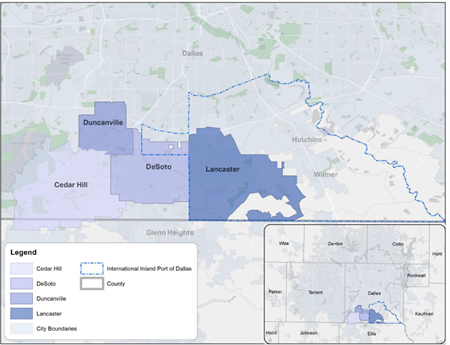Southern Dallas County Transit Study

Southern Dallas County Study Area Map
Study Outcomes
The Final Report focuses on the strategic implementation of transit and mobility services in the southern Dallas County communities of Cedar Hill, DeSoto, Duncanville, Lancaster, and the Southern Dallas Inland Port (Inland Port). The report provides service recommendations for these communities to implement transit and mobility services over the next 20 years using a phased approach: Phase 1 focuses on Years 1-5, Phase 2 on Years 5-10, and Phase 3 on Years 11-20. A 10-year Financial Plan accompanies the service recommendations and presents estimated costs (capital, operations and maintenance) alongside typically available revenue resources, as well as funding gaps that would need to be closed to fully implement the recommendations.
Additionally, a comprehensive goods movement needs assessment was performed in the Inland Port to understand the impacts on the local transportation system as well as job and real estate markets resulting from the area's rapid and significant growth in industrial and manufacturing development. Given the trajectory of future growth in the Inland Port, there are direct implications of freight and truck movement on existing transportation and transit infrastructure in the Inland Port (and adjacent areas), particularly on interstates and arterial roads.
Finally, an Implementation Plan was developed which outlines steps that municipalities and local partners should take to implement the service recommendations, while accounting for key infrastructure considerations in the Inland Port to accommodate continued growth in the area.
The service recommendations for Phases 1 and 2 are illustrated in the StoryMap below. Long-range considerations for Phase 3 are highlighted as well. The estimated operations cost for Phase 1 recommendations is $1.29M, and $2.12M for Phase 2.

The Implementation Plan for the service recommendations is summarized in this Table. Key implementation milestones and a suggested implementation schedule are highlighted in the Table; the flexible schedule provides detailed plans for the first five years (near-term) and more general recommendations for outer planning horizon years.
As the Inland Port has been experiencing significant job growth, it has also been adding industrial space at an even faster rate. If the historic pace of growth continues, Inland Port activity is poised to more than double over the next 10 years, with the potential to see more than 100 million square feet of new industrial development. To prepare for this continued growth, the table below outlines recommendations for roadway infrastructure that aim to accommodate the expected growth in truck volumes as well as facilitate safe and convenient transit travel.

Executive Summary
Final Report: includes all six Chapters of the report, including a summary of key findings from the transit existing conditions assessment as well as that of the comprehensive goods movement assessment.
Appendices: includes the full reports for both needs assessments, as well as the Financial Plan for each of the four cities.
For more information about the Southern Dallas County Transit Study, contact Andrew Pagano at apagano@nctcog.org.